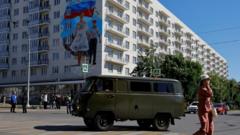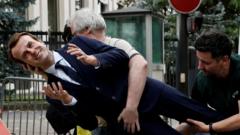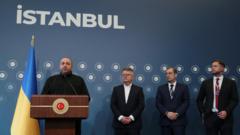This article explores the experiences of Ukrainians living in Russian-occupied territories, highlighting their struggles with identity loss, oppression, and subtle acts of defiance against the occupiers.
Resilience Amidst Shadows: Life Under Russian Occupation in Ukraine

Resilience Amidst Shadows: Life Under Russian Occupation in Ukraine
Ukrainians under Russian control share the harrowing realities and silent acts of resistance as they navigate life under occupation.
As Russia maintains control over roughly a fifth of Ukrainian territory, those living under occupation in cities like Melitopol, Mariupol, and Crimea face profound challenges. Interviews with three residents—Mavka, Pavlo, and Iryna—reveal the pressures they are under, from mandatory Russian citizenship to the fear of repercussions for minor acts of resistance.
Mavka, who has remained in her hometown of Melitopol since the invasion, witnesses a subtle yet pervasive "Russification" campaign. Schools have begun incorporating militaristic themes, with children wearing military uniforms and promoting Russian nationalism. Mavka is part of a female resistance group, Zla Mavka, which operates quietly to remind fellow Ukrainians of their identity and unity against the occupation.
In Mariupol, Pavlo describes a city that feels "cut off" from the outside world following a brutal siege. The reality is grim, as residents often discuss property claims and the surging cost of living in a landscape where homes have been severely damaged by bombing. Pavel also emphasizes that children risk severe consequences for displaying Ukrainian identity at school.
Iryna lives in Crimea, where the occupation has stripped public life of Ukrainian culture and identity since 2014. Speaking Ukrainian in public is now forbidden, and Iryna exercises caution, fearing violent repercussions. Despite this, she embodies resilience, donning her traditional vyshyvanka during private calls with friends, a symbol of her enduring connection to Ukrainian culture.
Resistance manifests in small ways; Mavka and her group distribute flyers and use social media to keep the spirit of resistance alive. Yet, the risks are real, and silence is a constant threat, as highlighted by the story of journalist Viktoriia Roshchyna, who disappeared while investigating torture allegations.
Mavka's fear is palpable: “Silent disappearance is what we dread most.” The clandestine nature of their resistance movements makes them acutely aware of their surroundings and the repercussions of their actions.
While the Ukrainian citizens under occupation remain determined to assert their identity, uncertainty looms over the possibility of a ceasefire or negotiation that may maintain the status quo. Mavka expresses concern that any agreement might forfeit their hope for reclaiming their identity, emphasizing their commitment to creative resistance in the shadow of oppression.
Conversely, Pavlo's perspective is shaped by a desire to see the war end, regardless of the implications for Ukraine. He reflects on the complexity and moral dilemmas faced in negotiating peace, understanding that myriad voices would be affected by such decisions.
As the situation evolves, all three individuals reflect on the psychological toll of life under occupation—a reality where hope, fear, and resistance coexist. Iryna tragically notes the effects of militaristic teachings on the next generation, as children emulate violence rather than peace, leaving her to ponder the future of her homeland.
In the backdrop of conflict, the stories of Mavka, Pavlo, and Iryna echo the larger struggle of Ukrainians under occupation, revealing both the heart-wrenching burdens they carry and their unyielding spirit of defiance.



















